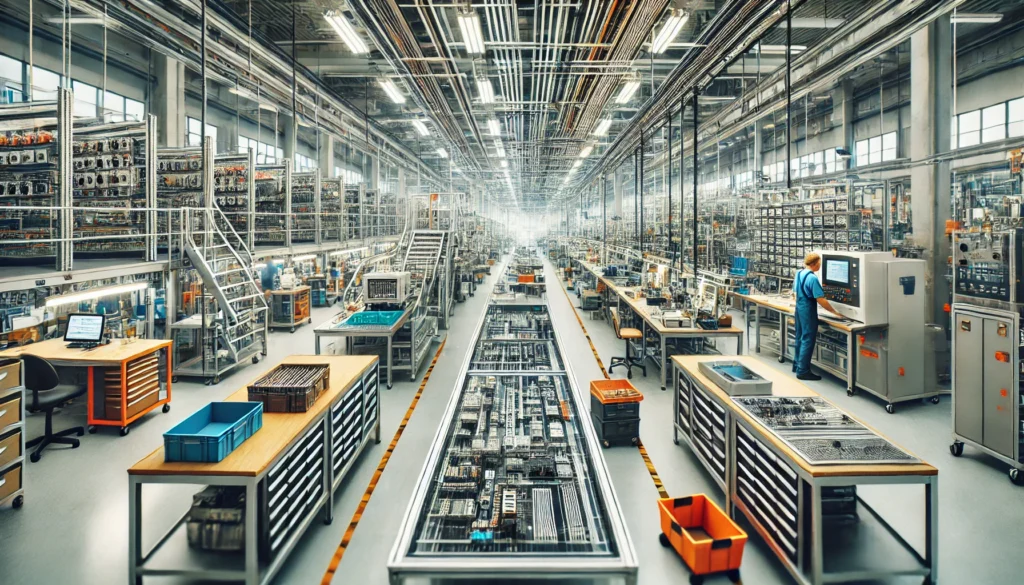
The global busbar market is undergoing significant growth, fuelled by the increasing demand for efficient power distribution solutions across various industries. As the world moves towards more sustainable and energy-efficient practices, busbar production is becoming a pivotal element in the electrical infrastructure.
What are Busbars?
Understanding Busbar Production and Its Importance in the UK and Globally
Busbars are essential components used in electrical power distribution. They are metallic strips or bars, typically made of copper or aluminium, that conduct electricity within switchboards, distribution boards, substations, and other electrical apparatus. The design and material of busbars allow them to carry large currents efficiently, making them crucial for modern electrical systems.
Where are Busbars Most Widely Used?
Busbars are used in a wide range of industries, including power generation and transmission, construction, automotive, aerospace, telecommunications, and more. They are commonly found in:
- Substations: Busbars distribute power from generators to transformers and other equipment.
- Switchgear: Used for controlling, protecting, and isolating electrical equipment to ensure the reliability and safety of the power system.
- Commercial Buildings: Busbars are used in office buildings, shopping centers, and hospitals for efficient power distribution.
- Residential Buildings: In residential complexes, busbars provide a safe and effective way to distribute power across multiple units and floors.
- Electric Vehicles (EVs): Busbars are critical for efficient power management within EV battery systems.
- Charging Stations: Busbars are used in EV charging infrastructure to manage the distribution of power to multiple charging points.
- Aircraft Electrical Systems: Busbars distribute power to avionics, lighting, and control systems.
- Spacecraft: Used in spacecraft for efficient power distribution in a weight-sensitive environment.
- Data Centres: Busbars provide power to servers, storage systems, and networking equipment.
- Telecom Towers: Used to distribute power to antennas and other communication equipment.
Industrial Applications of Busbar
Busbars are widely used in various industrial sectors, including manufacturing, metals and mining, and chemicals and petroleum. They support the high power demands of industrial equipment and processes, ensuring continuous and efficient operation. Examples include:
- Manufacturing Plants: Busbars distribute power to machinery, conveyors, and robotics.
- Metals and Mining: Used in smelting and refining operations to handle high current loads.
- Chemicals and Petroleum: Provide safe and reliable power distribution in hazardous environments.
Benefits of Using Busbars
Busbars offer several advantages over traditional wiring methods, making them a preferred choice for power distribution. Some of the biggest benefits include the following:
- The use of busbars reduces voltage drop, resulting in more efficient power distribution.
- Busbars have a higher current-carrying capacity compared to traditional wiring methods, allowing for higher power density in smaller spaces.
- Busbar systems are modular and can be easily reconfigured or expanded as needed. This allows for greater flexibility and reliability in the electrical infrastructure.
- Since busbars are manufactured in a controlled environment, they have fewer joints and connections, reducing the risk of electrical faults and fires.
Related: Silver Plating, Busbars and Specialist Coatings
Key Drivers of Increased Busbar Production (Market Growth Figures)
Increasing Demand for Efficient Power Distribution
The growing demand for reliable and efficient electricity distribution is a major driver of busbar production. Rapid urbanisation and industrialisation require robust power distribution systems. Busbars, with their high current-carrying capacity and efficiency, are integral to meeting these needs. According to the International Energy Agency, global electricity consumption reached 24,398 terawatt-hours in 2022, a significant increase from previous decades (Global Market Insights Inc.).
Infrastructure Development and Modernisation
Significant investments in infrastructure development, especially in emerging economies, are boosting busbar production. Modernising power grids and expanding transmission networks necessitate advanced busbar systems to ensure efficient and stable electricity distribution. For instance, substantial infrastructure projects in countries like China and India are driving the demand for busbars (IMARC).
Energy Efficiency Initiatives
With a global emphasis on energy efficiency and sustainability, busbars are gaining traction for their ability to minimise energy losses. Their low resistance and high efficiency make them ideal for modern electrical systems, contributing to overall energy savings and reduced carbon footprints (Research Markets).
Market Segmentation in Busbar Manufacturing
Busbar Production by Conductor Material
- Copper busbars dominate the market due to their excellent electrical conductivity and durability. They are widely used in various applications, including industrial and commercial power distribution (Expert Market Research).
- Aluminium busbars are increasingly popular for their lightweight and cost-effective properties. They are particularly advantageous in applications where weight reduction is critical, such as in electric vehicles and aerospace (Research Markets).
End-User Segments in Busbar Production
- Utilities: The utility sector holds the largest market share, relying on busbars for efficient power transmission and distribution in substations and grids.
- Industrial: Busbars are crucial in manufacturing and processing plants, where reliable power distribution is essential.
- Commercial and Residential: Growing focus on energy efficiency in commercial buildings and residential areas is driving demand for busbar systems (Expert Market Research).
Emerging Trends in Busbar Production
The adoption of smart grid technologies is creating new opportunities in busbar production. Smart grids require advanced busbar systems that support efficient power management and distribution. Innovations such as modular and 3D-printed busbars are becoming more prevalent (Research Markets).
The increasing focus on renewable energy sources, such as solar and wind, is boosting the demand for busbars. These systems are integral in the effective transmission of power from renewable installations to the grid and end-users (Global Market Insights Inc.).
Continuous improvements in busbar design and manufacturing are enhancing their performance and reliability. Innovations like laminated busbar technology and modular systems offer benefits such as reduced installation time and improved efficiency (IMARC).
Final Thoughts: Busbar Production & PRV Engineering
Busbar production is a critical aspect of modern power distribution systems. With rising electricity demand, significant infrastructure investments, and a focus on energy efficiency, the busbar market is poised for substantial growth. As technological advancements continue to enhance their efficiency and reliability, busbars will play an increasingly important role in the global electrical infrastructure.
PRV’s Busbars in the UK not only offer exceptional quality and value, but as a company, we fulfil all your needs for Busbars, Conductors, Copper Contacts, and Connections. Whether you are an international manufacturer of medium or high voltage distribution and transit switchgear, or an independent engineering contractor specialising in the maintenance, installation, and testing of low, high, and extra high voltage electrical equipment, we understand your requirements and deliver on busbar production when others cannot.
Additional Resources
For more detailed insights and statistics on busbar production and the market in general, here are several resources with comprehensive market reports and analyses from reliable sources. This includes IMARC Group, Expert Market Research, and Research and Markets (IMARC) (Expert Market Research) (Research Markets).


 Mail:
Mail: 





